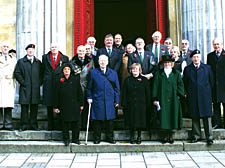|
|
 |
| |

Members of the St Pancras Old Comrades Association mark 90 years since the Armistice outside St Pancras Parish Church |
Hero veterans pay tribute to their fallen pals
Ex-soldiers recall war memories as regiment reunites for Armistice Day
VETERANS from the St Pancras regiment gathered on Tuesday to mark Armistice Day and remember fallen comrades.
The regiment, which was established in 1908 and was made up of Territorial Army-style volunteers, saw action in the front line of the Western Front in the First World War where 1,084 young men from the area were killed.
Prayers were read by the St Pancras vicar Paul Hawkins and veterans from the St Pancras Old Comrades Association were joined by Mayor of Camden Nurul Islam to lay wreaths at a memorial plaque in the St Pancras Parish Church on Euston Road.
Among those paying their respects was Second World War veteran Don Robbins, enlisted in the St Pancras regiment in 1936. An apprentice in a photograph engraving business, he was 17 and would meet other soldiers on Tuesday nights at a drill hall in Camden High Street to train. When war broke out, the regiment was given vital duties manning searchlights to help the RAF defend London during the Blitz.
Sent to a battery in Hertfordshire, he watched German bombers attack the city.
Mr Robbins recalled: “We had searchlights with 10 men manning them.
“You lived with the searchlight, camped around them in bell tents. That first winter was freezing and the conditions were terrible. You had to be self-sufficient and whoever could fry an egg was appointed the cook. It was a very rough life.
“We stayed up all night and picked out the German bombers with our lights.”
For protection, they were armed with a Lewis machine gun to ward off dive bombers who attacked their positions. And the psychological effect of seeing wave upon wave of Luftwaffe planes heading to London also took its toll.
Mr Robbins said: “I would worry constantly about my mother and sister who were still in London and who these planes were dropping bombs on. Even from Hertfordshire you could see all of London lit up by fire. It was absolutely terrible.”
As radars developed, searchlights were used in conjunction with better intelligence and the unit was transferred to the coast to help ward off the threat of invasion. As the war gradually turned against the Nazis, Mr Robbins was transferred to the Middle East, and demobbed in 1946. He returned to London to finish his photo engraving apprenticeship which the war had interrupted.
Secretary of the association Carl Crane told the story of his great-grandfather, Private Cecil Crane. The father of three, who lived in Camden, had been conscripted in 1916 and sent to Palestine, where the regiment took part in the battle for Jerusalem. They spent Christmas Day in the city and then went to fight along the banks of the river Jordan. During an attack to capture a hill from Turkish forces, Private Crane was killed. His great-grandson said his last words were that the place he and his comrades had been sent was a “death trap”.
Mr Crane said: “My great-grandfather had a wife and family he had to leave behind and his youngest – my grandfather – was only a year old when he died. He was buried in a war cemetery in Jerusalem, thousands of miles from his home.” |
 |
|
|
 |
| |
| |
|
 |
|